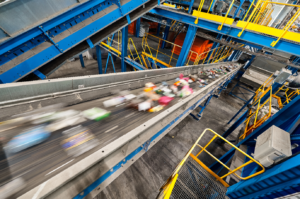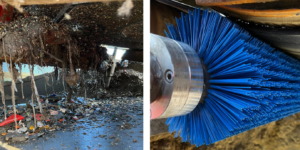Matthew Beverley, Chairman at Hoverdale UK and Vice President of the MHEA (Materials Handling Engineers Association), looks at how waste & recycling processing facilities can make quick technological improvements to their conveyor belt systems to keep materials flowing out and money flowing in.

Materials Recovery Facilities (MRFs), also sometimes called material recycling or reclamation facilities, sit between our waste and the value extracted from the reuse and recycling of that waste.
Optimised equipment and workflows in MRFs
Conveyor belt systems in the recycling and waste sector are a critical component. Robust, solid, reliable conveyor systems enable converting waste into quality recyclables and alternative fuels. Conveyor equipment is generally designed to efficiently sort and process recyclable materials, which can help increase the facility’s overall efficiency. Safety, quality, and productivity are the three components that maximise waste and recycling facility efficiency. MRF operators can do plenty to make their operations more efficient, particularly in today’s economic climate in the face of rising energy costs. Planned and preventative maintenance of systems will help the system keep running because a faulty line is one of the big points for inefficiencies and energy loss.
MRF Case Study: Keeping chevron and cleated conveyor belts clean at an MRF
The client, a large national waste and recycling provider, runs a Material Recovery Facility that processes tonnes of household waste and recovers material for recycling. They were experiencing issues on conveyor systems with carryback and spillage of materials. Belly pans full of material, and various other blockages in the system were causing multiple stoppages. The build-up of materials on unclean belts causes premature belt damage, wear and tear. In this case, the return rollers were wrapped in material and damaged, and the drive drum motors were overloaded.
Health & Safety Hazards in MRFs
Guidance developed by the Waste Industry Health and Safety (WISH) Forum to help control safety and health risks in the waste management industry associated with designing and operating material recovery facilities (MRFs) safely. The guidance advises on material recovery facilities’ leading health, safety and welfare issues. The guidance is primarily aimed at designers/manufacturers, installers and users involved in developing and operating MRFs. It explains how to remove or reduce critical general health and safety risks associated with designing and operating an MRF. It includes advice about assessing hazards and provides solutions that will help eliminate or reduce the risk of serious injury or ill health. It’s not only health and safety risks that need to be considered.
In this case, the issues caused spillage on the facility floor and gangways, causing a health and safety hazard and requiring frequent additional clean-up and resources. When the material becomes airborne, there is a risk of exposing site workers to potential workplace injuries and respiratory diseases.
The rubber conveyor belts are cleated and chevron in construction, so conventional-style belt cleaners are unsuitable. A different approach was needed to overcome the conveyor belt’s construction and provide effective belt cleaning to prevent carryback and spillage.
If material is allowed to build up on the conveyor belt surface, it leads to carryback, which causes extra wear and tear on the rollers and drum. This increases maintenance costs and shortens the life of the machine.

A motorised brush belt cleaner was the ideal solution to tackle this challenge. The system was initially designed to clean chevron and cleated belts that conventional contact belt scrapers could not clean effectively. However, it soon became apparent that the system was also very effective in all types of belt construction. Through many years of activity in the field,
we have proven data that shows a reduction in belt stoppages, increasing uptime and allowing more materials to be processed through the facility.
The Hoverdale motorised brush belt cleaners are stainless steel in construction and auto-adjust as the brush wears to maintain effective cleaning contact with the conveyor belt at all times. Because it’s made of stainless steel, it prevents corrosive material damaging the belts and withstands extreme weather conditions., A range of cleaning brush diameters results in cleated belts up to 150mm in height still being cleaned effectively. Quick-release cartridge systems allow fast and easy changeover of brushes.
The results and benefits cost saving and ROI of our Motorised Brush Belt Cleaners
Carryback was eliminated, and the system avoided blockages. The return belt and rollers are now kept clean and free of material. No cleaning resource is required to remove material from the facility floor, and health and safety risks are reduced. Belly pans are kept clean and free of material, resulting in reduced downtime, and increased uptime and the client was able to maintain stable production levels. Reduced wear of conveyor belts and rollers reduces ongoing costs and requires minimal maintenance. This helps to reduce the contamination of the materials themselves, which can improve the quality of the recyclables and increase their value. We work closely with customers to establish the baseline running costs of the MRF plant or a specific conveyor line which includes; Cleaning costs for spillages, loss of valuable material, blockages, return roller wear, and carryback from belly pans. Mostly issues that lead to the most costly event of downtime.
Our MRF customers always strive for continuous improvement to have the most efficient facility. They won’t substitute safety or quality to keep lines running. If you run an MRF safely, the facility will naturally be more efficient. Once we have the data, we can accurately predict savings from the improvements made by installing the motorised brush belt cleaner and establish the ROI. The transparent and detailed approach quickly demonstrates the tangible benefits to the plant, reducing stoppages and improving uptime.
Hoverdale provides hard metals and wear-resistant products, conveyor belt products and equipment. We keep waste recycling, biofuel, power generation, wastewater treatment, sea aggregates, vinyl, food, mining, tunnelling and glass plants moving, maximising the total cost of ownership of any bulk handling environment.
Trial a Hoverdale motorised brush and eliminate the root causes of dirty belts.
- Stainless steel construction
- Auto-adjusting options
- Automated options available
- Brush diameters available from 200mm to 600mm to cover flat, chevron, and flighted belts.
- Quick-release cartridge systems allow brushes to be changed in 15 minutes without the need to remove the shaft from the gearbox or bearing.
- Effective in a range of industries and materials.
Hoverdale’s Promise: Made in the UK, our products are used on five continents, and our expertise spans the globe. Here’s our promise to you:
- Free No Obligation Site Survey
- All our systems are designed, manufactured, and installed by qualified Hoverdale Engineers
- We offer a 100% money-back guarantee that we will solve the issues
- Committed after-sales and technical support for ongoing system performance.
100% satisfaction is guaranteed with a try before you buy. Increase uptime and contact the team to find out how we can help. Please email us here.





